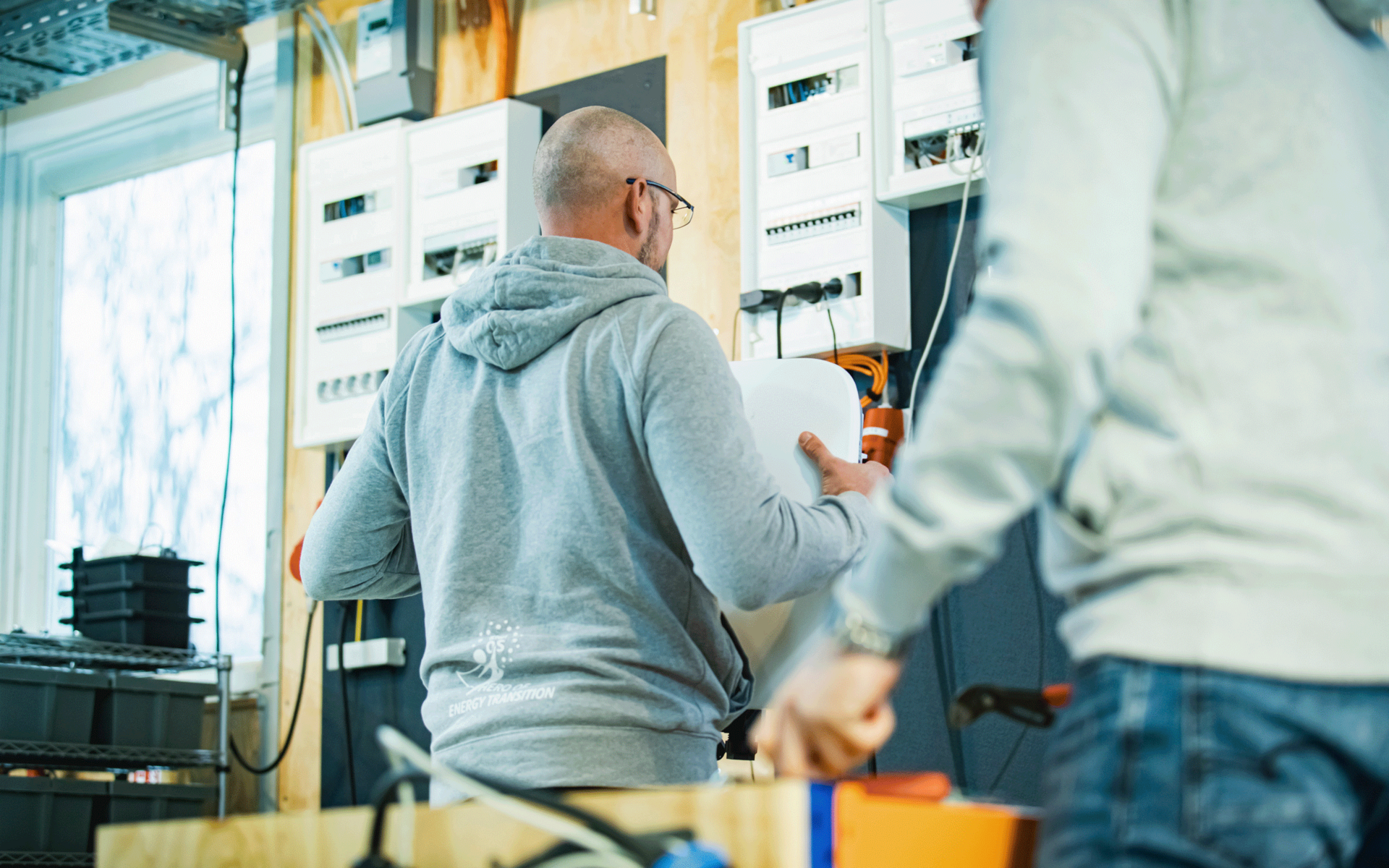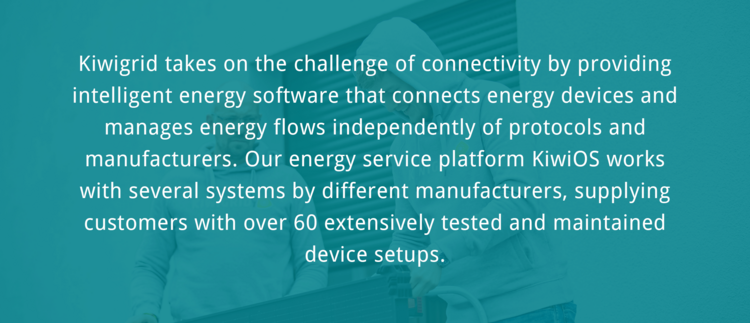While we’re still grappling with the need to significantly increase renewable energy production, the next challenge is upon us. To truly converge the sectors of electricity, mobility and heat, we need to connect their respective devices and systems.
More people than ever are consuming self-produced energy. To optimize energy consumption and enable an efficient energy flow in the home, all their energy devices such as PV systems, EV chargers and heat pumps must be interconnected. However, the great variety of devices coming from different manufacturers means that this connectivity isn’t easily guaranteed. In this blog, we share with you Kiwigrid’s market-leading progress in device connectivity.
The importance and complexity of connecting PV systems, EV chargers and heat pumps at home
The transition to a decentralized green energy system means an explosion in the number and types of devices. In 2020, more PV systems were installed in Germany than any previous year: 150,000; 120,000 of those in combination with energy storage. Heat pump sales were up to 154,000 in 2021. And in 2020 338,000 EV home chargers by numerous manufacturers were sold. The different models by the various manufacturers offer different interfaces and protocols that need to be connected to integrate with one another. Only with maximum connectivity can we actually bring about sector convergence in the home.
The significance of lab capacity to test individual device connections and system-level device setups
Kiwigrid’s test labs
Kiwigrid has two locations for independent system validation that provide facilities for a wide variety of device setup testing. The laboratory at the Kiwigrid headquarters in Dresden and a new site in Neuwiese, also in Saxony, Germany, are state-of-the-art test facilities. They provide us with a large number of installed devices such as EV chargers, PV and hybrid inverters, AC and DC-coupled energy storage systems and heat pumps by different manufacturers and offer the possibility to connect EVs.
Here we test everything: from the more straight-forward device connections to our own platform, to the much more complex complete system setups for all our use cases, including PV self-consumption, solar-optimized EV charging and smart heat pump operation. Testing establishes the individual adaptations we need to make in our system so that our Energy Manager can work with any given device. They range from adapting to capacity settings to security protocols.
In addition to our two labs, we’re able to use our own EV fleet consisting of a variety of EVs to validate device-setups involving EV chargers.
Kiwigrid’s partner network for device management
We work with a network of partners including SMA, Kostal, Fronius, Webasto, Mennekes, Keba, Solarwatt, Varta and many more who we are in constant exchange with. This is particularly important for driver development and establishing initial connectivity as these require device information as well as actual devices for testing.
Our partner network also helps us to ensure continued connectivity as we are updated promptly about beta versions, firmware updates regarding security, functionality, robustness and stability, and any other news about devices on the market, entering the market or being discontinued. Any such update, whether automatic or manually added, must be tested to ensure continuous and smooth functioning. We’re also lucky enough to count on the contributions of numerous friendly users who test our lab results in the field. Even when OEMs don’t publicize their interfaces or when premature interfaces are launched in the market, our extensive testing capacities allow us to establish connectivity.
From the lab to everyday life – connecting all energy devices in the home
With demand for smart energy devices rising sharply and more and more manufacturers entering the market, device compatibility is a significant concern for our customers, installers and homeowners. Will new purchases and upgrades or replacements of old devices still be compatible with already installed components?
Our Energy Manager is a field-proven gateway that meets installers’ high demands for safety and durability. It connects PV or hybrid inverters, EV chargers, heat pumps, heating rods, smart plugs, smart meters and energy storage systems manufactured by various OEMs via RS485, RS232, DIO, SO and Ethernet interfaces.
This allows homeowners to select from a wide variety of hardware setups independently from OEMs. For example, they could use a PV system from SMA and connect it to a storage system from Solarwatt. Furthermore, all devices can be managed within one app, which our customers can offer their end customers as a white-label product.
The staggering complexity of manufacturer-independent sector convergence
Devices and manufacturers
Kiwigrid has over 10 years’ expertise efficiently integrating devices across sectors and manufacturers. Compatible devices and OEMs include:
- For PV or hybrid inverters: SMA, Fronius, Kostal, Huawei, Steca and Sungrow
- For energy storage systems: BYD, LG Chem, LG Electronics, Varta, Solarwatt, Huawei, and E3DC
- For EV chargers: ABL, Webasto, Mennekes, Keba, Delta and Alfen
- For heat pumps: all SG-ready heat pumps (supported by all large OEMs such as Vaillant, Stiebel Eltron, Nibe, Bosch, Buderus, Viessmann)
- For smart meters: ABB, EasyMeter, Iskra, Iltron, Janitza, Kamstrup, SAIA (SBC), Schneider Electric, ZPA and S0 meter
Device setups
This high degree of compatibility enables us to supply customers with over 60 extensively tested and maintained device setups, in addition to ensuring the individual device connections to our own platform. As a result, homeowners can rely on the interconnectivity of their energy devices and gain future security because they know that they will be able to purchase a new device from another manufacturer at a later date. Example device setups that work with KiwiOS:
- SMA Sunny Boy (PV inverter) + Varta Pulse (energy storage with integrated inverter) + Webasto Live (EV charger) + SG-ready heat pump + Schneider Electric Energy Meter
- Fronius Symo Hybrid (hybrid inverter) + LG Chem RESUesu (energy storage) + Mennekes AMTRON Xtra (EV charger) + SG-ready heat pump + Fronius Smart Meter
- Kostal Plenticore Plus (hybrid inverter) + BYD Battery-Box Premium (energy storage) + ABL eMH3 Single (EV charger) + SG-ready heat pump + Kostal Meter
- Steca coolcept fleX XL inverter + Solarwatt Battery flex + Webasto Live EV charger
Interfaces and protocols
We’re currently working on connectivity via EEBus, which will be particularly relevant for heat pumps and e-mobility. We already support the following interfaces and protocols:
- Interfaces: RS-485, Ethernet, S0, and depending on the gateways CAN, Digital In/Out, Bluetooth and USB
- Protocols: Sunspec, Modbus RTU, Modbus TCP, SML, OCPP 1.6, SG Ready and REST API, as well as proprietary protocols such as the Mennekes Home Charge Protocol (MHCP), SMA Speedwire and Kamstrup Meter Protocol (KMP)
Benefits of connectivity for installers and customers
OEM-agnostic device connectivity creates significant benefits for homeowners, Kiwigrid customers and installers. Homeowners can select from a greater variety of hardware setups independently from OEMs, which is incredibly important when it comes to expanding your system or buying state-of-the-art renewals. Resellers and installers can sell a larger variety of hardware setups, enabling them to address their customer preferences for brands more individually and to increase their independence from OEMs.
Connectivity isn’t a luxury. It’s a fundamental component for a successful energy transition. Are you a system distributor, OEM, energy service provider or energy supplier? Get in touch with us!

